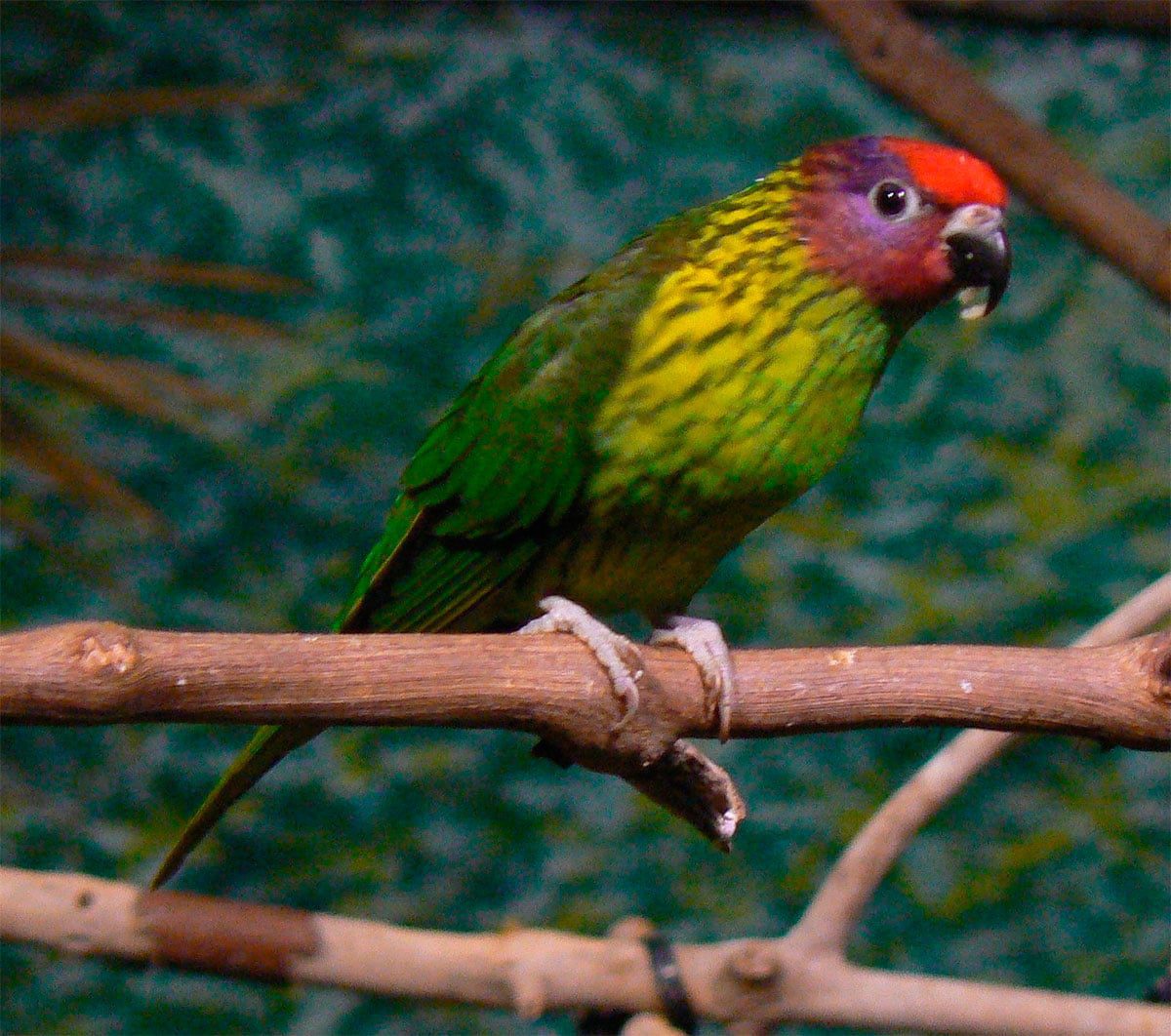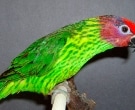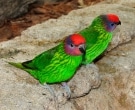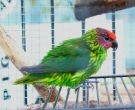Content |
|---|
Description
19 cm.. long and weighing between 45 and 60 g..
The Goldie's Lorikeet (Psitteuteles goldiei) has the top red. Its neck is surrounded by a strip blue opaque that it extends to the edge of the eye.
The mumps and their cheeks They are pink with multiple dark blue veins.. The upperparts of color green dark streaked of black in the part inferior of the neck and of color yellow greenish mottling on the sides of the layer.
The feathers that cover the wing
are dark green, as well as the top of the tail.
The feathers they have a green color with black internal wires and a fine yellow edge.
The underparts are yellowish green with many streaks of dark green, more concentrated in the area of the chest. The bottom of the tail is of color yellow grey.
The bill is black, brown the iris. The legs son grises.
The females adult, they have the top more opaque and less developed.
In the immature, the top is reddish with dark blue spots. The upper mantle is spotted of yellow.
There are no geographic variations. The species is considered monotype.
- Sound of the Goldie's Lorikeet.
Habitat:
The Goldie's Lorikeet It is distributed mainly by primary forests, mountain forests and eucalyptus between 1.000 and 2.200 meters above sea level. But, These birds are very Mobile and their habitat may vary from sea level to the 2.800 m.
At higher altitudes, sometimes be parked in the forests of beech and false Podocarpus. They are also set fairly regularly in the areas where the trees are in bloom and around small mountain villages. They have been , occasionally, in small groups of trees isolated in the middle of open spaces.
The Goldie's Lorikeet they are very sociebles. They are often associated with other Charmosyna type Loris: Fairy Lorikeet (Charmosyna pulchella) and Lori Flanquirrojo (Charmosyna placentis).
Most of the time they live in large groups of 30 or more individuals. These birds make long flights daily, often in the company of Pygmy Lorikeet (Charmosyna wilhelminae). Move from their places of rest to its feeding sites found at the middle level, or at the top of the tall trees in flower.
They probably make seasonal migrations to meet their specific feeding needs.. Between mid June and early January, the Goldie's Lorikeet they are common in the forests of the lowlands around Port Moresby.
Reproduction:
We really know very little about free-range breeding.. Apparently, the nest is well hidden inside a tree in thick foliage dry, mostly big pandanus. The female lays two white eggs.
In captivity, the incubation period ranges between 23 and 24 days. Young are altricial, and leave the nest after 8 to 9 weeks.
Food:
The Goldie's Lorikeet they have a scheme rather similar to all the lori, that is to say, they are almost exclusively vegetarian. Its menu consists mainly of pollen, nectar, flowers and fruits than that found in the trees of the genus Casuarina in shrubs of the genus honey Grevillea and of the eucalyptus.
Distribution:
Size of the area of distribution (reproduction / resident): 307.000 km2
This species is endemic of New Guinea. Lives exclusively in the mountains in the center of the island and stretches to the mountains of the Huon Peninsula and Owen Stanley.
Conservation:
– Current IUCN Red List category: Least concern
– The population trend: Stable
The population suspected to be stable in the absence of evidence of any reduction or substantial threats.
The world population It has not been quantified, It is estimated above 100.000 specimens, but the species is reported to be locally common depending on food availability.
"Goldie's Lorikeet" in captivity:
The Goldie's Lorikeet is a bird prized as a pet. His character is not aggressive, or destructive and is quite silent for a parrot. They can be taken in pairs or in large communities. Some of them come to imitate the human voice.
Alternative names:
– Goldie’s Lorikeet, Red-capped Streaked Lorikeet, Red-capped Streaked Lory (ingles).
– Loriquet de Goldie (French).
– Veilchenlori (German).
– Lóris-de-goldie (Portuguese).
– Lori de Goldie, Tricogloso de Goldie (español).
scientific classification:
– Order: Psittaciformes
– Family: Psittaculidae
– Genus: Psitteuteles
– Scientific name: Psitteuteles goldiei
– Citation: (Sharpe, 1882)
– Protonimo: Trichoglossus Goldiei
Images “Goldie's Lorikeet”:
————————————————————————————————
“Goldie's Lorikeet” (Psitteuteles goldiei)
Sources:
– Avibase
– Parrots of the World – Forshaw Joseph M
– Parrots A Guide to the Parrots of the World – Tony Juniper & Mike Parr
– BirdLife.org
– Wikipedia
– Photos:
1 – “Psitteuteles goldiei - Pittsburgh National Aviary-8-3 c” by derivative work: Snowmanradio (talk)Psitteuteles_goldiei_-Pittsburgh_National_Aviary-8.jpg: Benny Mazur – originally posted to Flickr as Goldie’s Lorikeet and uploaded to commons as Psitteuteles_goldiei_-Pittsburgh_National_Aviary-8.jpg. Licensed under CC BY 2.0 via Wikimedia Commons.
2 – animalhouse.Re.it
3 – “Goldies Lorikeet” by Ltshears – Own work. Licensed under CC BY-SA 3.0 via Wikimedia Commons.
4 – Jackson Zoological Park – Jackson, MS, USA © 2004 Jeff Whitlock
5- Bird feeding on fruit in a tree. by David Cook Wildlife Photography – IBC.lynxeds.com
– Sounds: Michiel de Boer (Xeno-canto)






